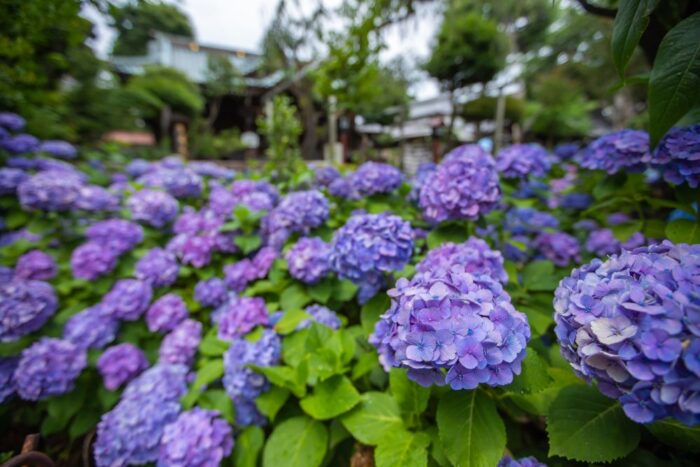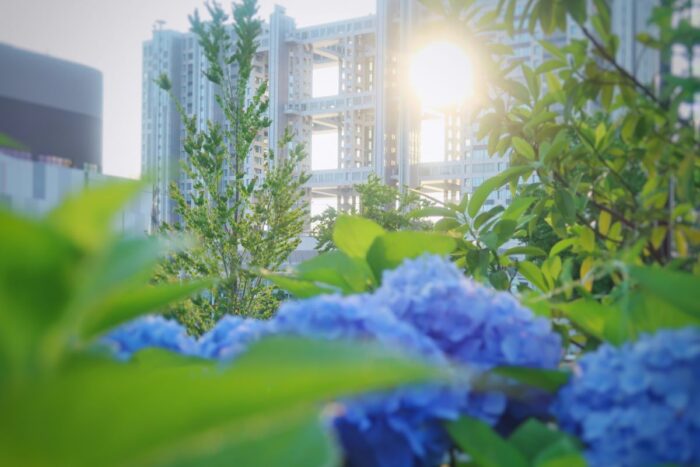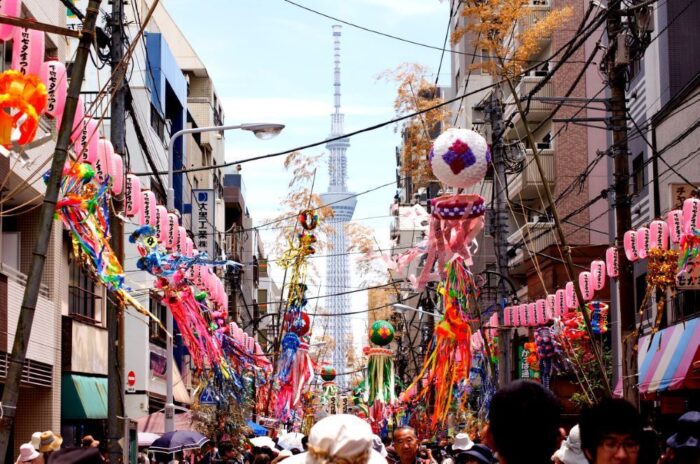Japan’s enchanting hydrangea festival is a vibrant celebration of color and culture. With over 100 varieties of hydrangeas adding a burst of hues to public parks and private gardens, these flowers hold a special place in Japan’s history.

Despite the European influence that introduced new colors and characteristics, native hydrangeas have remained prominent. The Yanagidani Kannon Hydrangea Week and Fujinomori Shrine Ajisai Matsuri are two renowned festivals that attract visitors from far and wide.
These celebrations offer a delightful mix of music, poetry, and sports, showcasing the beauty and diversity of hydrangeas.
Key Takeaways
- Hydrangeas have a rich history dating back to the 8th century in Japan and hold cultural significance.
- There are over 100 varieties of hydrangeas in Japan, including native and European varieties.
- Hydrangea festivals, such as Yanagidani Kannon Hydrangea Week and Fujinomori Shrine Ajisai Matsuri, celebrate the beauty and diversity of hydrangeas and attract visitors from all over Japan and the world.
- Kyoto is known for its breathtaking hydrangea spots, including Mimurotoji Temple, Maizuru Natural Culture Garden, Yoshiminedera Temple, Sanzenin Temple, and Umenomiya Taisha Shrine.
Origins and History

Hydrangeas have a rich history dating back to the 8th century in Japan, and their popularity has only grown with the introduction of European varieties in the early 20th century. These beautiful flowers have been cultivated for centuries in Japan, where they hold deep symbolic meanings.
Hydrangea cultivation in Japan began with native varieties, which were highly valued for their vibrant colors and ability to thrive in different climates. Over time, European varieties were introduced, bringing new colors and characteristics to the Japanese hydrangea landscape. Today, there are over 100 varieties of hydrangeas in Japan, each with its unique beauty and charm.
These flowers are not only admired for their visual appeal but also for the symbolic meanings they represent, such as gratitude, understanding, and heartfelt emotions. From ancient times to the present day, hydrangeas continue to captivate people with their enchanting beauty and cultural significance.
Popular Varieties
With over 100 varieties to choose from, visitors to the festival can enjoy the vibrant and diverse range of hydrangeas on display. These stunning flowers come in an array of colors, each with its own symbolism and beauty.
Here are five popular varieties that captivate festival-goers:
- The vivid blue hydrangea represents gratitude and understanding, evoking a sense of calm and tranquility.
- The delicate pink hydrangea symbolizes love and romance, emitting a soft and romantic ambiance.
- The pure white hydrangea embodies purity and grace, creating an elegant and timeless atmosphere.
- The vibrant purple hydrangea signifies wealth and abundance, adding a touch of luxury to the surroundings.
- The enchanting green hydrangea represents fertility and new beginnings, infusing the festival with a sense of freshness and vitality.
These hydrangeas, cultivated with care, create a magical experience for all who attend the festival. Their colors and symbolism enhance the beauty and cultural significance of this enchanting event.
Hydrangeas in Kyoto
Kyoto, known for its breathtaking scenery, offers a multitude of locations where vibrant and diverse hydrangeas bloom. The city’s stunning Japanese gardens serve as the perfect backdrop for these seasonal attractions. Visitors can immerse themselves in the beauty of nature while exploring the enchanting hydrangea spots scattered throughout Kyoto. From the nearly 20,000 hydrangea shrubs at Mimurotoji Temple in Uji City to the serene setting of Yoshiminedera Temple, there is no shortage of picturesque locations to witness the blooming of these captivating flowers. The Maizuru Natural Culture Garden showcases not only hydrangeas but also almost 100 different flower species, creating a stunning display of color and fragrance. As visitors wander through these gardens, they are transported to a world of tranquility and natural beauty. Kyoto truly is a paradise for lovers of Japanese gardens and seasonal attractions.
| Location | Description |
|---|---|
| Mimurotoji Temple | Nearly 20,000 hydrangea shrubs in Uji City |
| Maizuru Natural Culture Garden | Offers almost 100 different flower species |
| Yoshiminedera Temple | Countless hydrangeas in a serene setting |
| Sanzenin Temple | Ajisai in an expansive moss garden in Ohara town |
With each step, visitors are greeted by a kaleidoscope of colors and the delicate fragrance of the hydrangeas. These vibrant blooms create a sense of peace and harmony, inviting people to slow down and appreciate the beauty of nature. Whether it’s the vibrant blue, pink, or white petals, each variety of hydrangea adds its own unique charm to the landscape. Kyoto’s hydrangea spots are not only a feast for the eyes but also a place to relax and rejuvenate. As visitors meander through these gardens, they can’t help but feel a sense of awe and wonder at the beauty that surrounds them. Kyoto’s hydrangea spots truly are a sight to behold, offering a glimpse into the rich cultural heritage and natural beauty of Japan.
Sacred Shrines and Gardens
Visitors to sacred shrines and gardens in Kyoto can immerse themselves in the rich cultural heritage and natural beauty of these enchanting locations. These serene and sacred spaces not only offer a peaceful retreat from the bustling city but also provide a glimpse into Japan’s cultural traditions and symbolism.
One of the most captivating aspects of these shrines and gardens is the presence of ajisai, or hydrangeas, which hold special significance in Japanese culture. The ajisai symbolism is deeply rooted in tradition, representing gratitude, understanding, and heartfelt emotions.
In addition, traditional ceremonies often take place in these sacred spaces, further enhancing the spiritual atmosphere. From the mesmerizing beauty of the ajisai blooms to the solemnity of the traditional ceremonies, visiting these sacred shrines and gardens in Kyoto is a truly immersive and enriching experience.
Cultural Significance
The cultural significance of ajisai is deeply ingrained in Japanese traditions and holds a special place in the hearts of the locals. This beautiful flower, also known as hydrangea, is not only admired for its vibrant colors and delicate petals, but it also represents important cultural values and artistic expressions.
In Japanese cultural traditions, ajisai symbolizes gratitude, understanding, and heartfelt emotions. It is often associated with the fleeting nature of life and the beauty that can be found in impermanence. The Japanese people express their appreciation for ajisai through various artistic forms such as poetry, painting, and flower arranging. These artistic expressions capture the essence of ajisai’s beauty and evoke a sense of tranquility and harmony.
To further illustrate the emotional impact of ajisai, here is a table showcasing the different cultural meanings attributed to specific colors of the flower:
| Color | Cultural Meaning |
|---|---|
| Pink | Love and Romance |
| Blue | Serenity and Tranquility |
| Purple | Wealth and Royalty |
This table not only provides information about the cultural symbolism of ajisai, but it also evokes an emotional response, allowing the audience to appreciate the depth of meaning behind this enchanting flower.
Festival Events and Highlights
During the festival events, visitors can enjoy music performances, poetry readings, and sports demonstrations. The atmosphere is vibrant and lively, with people from all walks of life coming together to celebrate the beauty of hydrangeas.
Traditional performances, such as traditional music and dance, add to the cultural experience of the festival. Food stalls offering a variety of delicious treats are scattered throughout the venue, enticing visitors with the aroma of freshly cooked delicacies. From savory snacks to sweet desserts, there is something for everyone to indulge in.
The festival also provides an opportunity for sports enthusiasts to witness thrilling sports demonstrations, showcasing the skill and agility of athletes. Whether you’re a music lover, poetry enthusiast, or simply a foodie, the festival has something to offer for everyone, making it a must-visit event for all.
Must-Visit Locations

As the festival events and highlights come to a close, it’s time to explore the must-visit locations for an enchanting experience of Japan’s hydrangea festival.
From sprawling botanical gardens to serene temples, these locations offer breathtaking landscapes adorned with vibrant hydrangeas.
One such destination is the Maizuru Natural Culture Garden, where visitors can immerse themselves in the beauty of almost 100 different flower species, including stunning hydrangeas.
For a peaceful retreat, Yoshiminedera Temple on the outskirts of Kyoto boasts countless hydrangea blooms amidst a tranquil setting.
And for those seeking a truly immersive experience, the Umenomiya Taisha Shrine offers extended viewing sessions with around 60 different varieties of ajisai in their botanical garden.
These must-visit locations showcase the diversity and splendor of Japan’s hydrangea festival, captivating visitors with their awe-inspiring beauty.
Enchanting Blooms
Visitors can explore the diverse and vibrant blooms at these must-visit locations during Japan’s hydrangea festival. The blooming seasons of hydrangeas in Japan vary depending on the region and climate. However, the peak season for hydrangeas is generally from May to July. During this time, the countryside and cities alike burst with the colorful and enchanting blooms of hydrangeas. Floral arrangements showcasing these beautiful flowers can be found in parks, gardens, and shrines throughout the country.
To emphasize the beauty and diversity of hydrangeas during the festival, here is a table showcasing some of the popular locations and their distinctive features:
| Location | Blooming Seasons | Floral Arrangements |
|---|---|---|
| Mimurotoji Temple | May to June | Nearly 20,000 shrubs |
| Maizuru Natural Culture Garden | May to July | A stunning display of various flower species |
| Yoshiminedera Temple | June | Countless hydrangeas |
| Sanzenin Temple | June | Ajisai in expansive moss garden |
These locations offer breathtaking views of hydrangeas in full bloom and provide a serene and peaceful atmosphere for visitors to enjoy. Whether it’s strolling through a temple garden or walking along a park path, Japan’s hydrangea festival is a feast for the eyes and a celebration of nature’s beauty.
Frequently Asked Questions
What is the origin of the name “hydrangea”?
The origin of the name ‘hydrangea’ is derived from the Greek words “hydor” meaning water, and “angeion” meaning vessel. This refers to the plant’s need for abundant water and the shape of its seed capsules. Hydrangeas have a long and significant history in Japan, being cherished for their vibrant colors and cultural significance.
Are there any traditional rituals or customs associated with hydrangea festivals in Japan?
Traditional rituals and customs are an integral part of hydrangea festivals in Japan. These rituals, rooted in the country’s rich cultural significance, include tea ceremonies, flower arranging, and prayers for good fortune and blessings.
How do hydrangeas contribute to the local ecosystem and biodiversity?
Hydrangeas play a crucial role in pollination as they attract bees, butterflies, and other insects with their vibrant flowers. Additionally, the fallen petals and leaves of hydrangeas contribute to soil health by decomposing and enriching the soil with organic matter.
Are there any special meanings or symbolism associated with different colors of hydrangeas?
Different cultural associations and significance in flower language are attributed to different colors of hydrangeas. For example, blue hydrangeas symbolize gratitude and understanding, while pink hydrangeas represent love and heartfelt emotions.
Are there any famous artists or poets in Japan who have depicted or written about hydrangeas?
Famous artists and poets in Japan, such as Yosa Buson and Utagawa Hiroshige, have depicted and written about hydrangeas. The influence of hydrangeas on Japanese art and literature is evident in their beautiful and vibrant representations.
Conclusion
In conclusion, Japan’s enchanting hydrangea festival is a captivating celebration of color and culture. With a rich history dating back centuries, hydrangeas have become a prominent feature in Japanese parks, gardens, and private properties.
The festival showcases the beauty and diversity of hydrangeas, offering visitors the chance to enjoy various cultural events and explore stunning locations like Kyoto’s breath-taking hydrangea spots. From sacred shrines to peaceful gardens, the festival highlights the cultural significance of these enchanting blooms.
It truly is a must-visit experience for anyone seeking to immerse themselves in Japan’s vibrant traditions.




